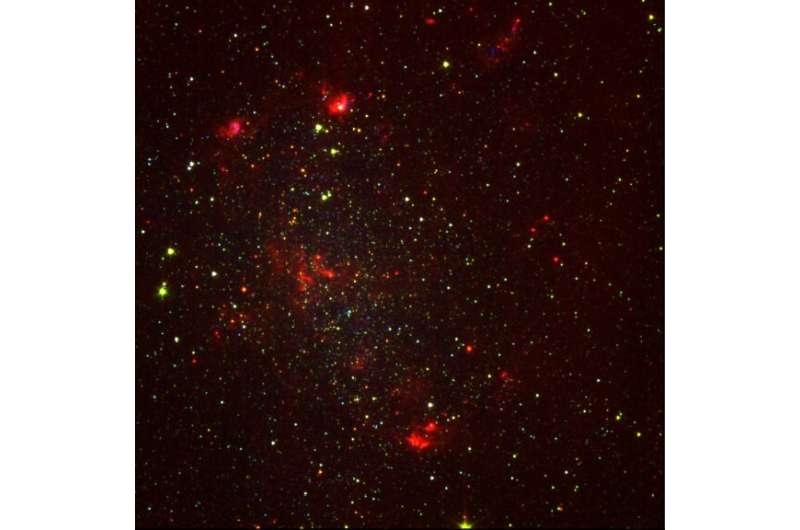March 9, 2020 report
Astronomers identify nearly 3,000 candidate stars of a nearby star-forming galaxy

Using the United Kingdom Infrared Telescope (UKIRT) and NASA's Spitzer Space Telescope, astronomers have conducted photometric observations of a nearby star-forming galaxy known as NGC 6822. They have identified nearly 3,000 candidate stars of this galaxy, which is reported in a paper published February 27 on the arXiv pre-print server.
Located some 1,6 million light years away from the Earth, NGC 6822 is an isolated, metal-poor, star-forming barred irregular galaxy. Taking into account the galaxy's proximity, its isolation and low metallicity, it seems to be an ideal target for studying resolved stellar populations.
Moreover, NGC 6822's metal-poor nature and active star-formation characteristics make it an important analog to the active galaxies in the universe at the epoch of peak star formation. The galaxy is perceived as a useful laboratory that could improve the knowledge of the dust life cycle in the early universe.
A team of astronomers led by Alec Hirschauer of the Space Telescope Science Institute in Baltimore, Maryland, used UKIRT and Spitzer to identify dusty and evolved stars in NGC 6822. Near and mid-infrared photometry allowed them to to find dust-producing evolved stars, including red supergiant (RSG) and thermally-pulsing asymptotic giant branch (TP-AGB) star candidates in this galaxy.
"In this study, we have combined near- and mid-IR photometric data from Sibbons et al. (2012) and Khan et al. (2015) of the nearby, metal-poor dwarf star-forming galaxy NGC 6822 to produce a catalog useful for characterization of dusty and evolved stars," the researchers wrote in the paper.
The study identified 2,902 dusty and evolved candidate stars, out of which 1,292 are categorized as RSGs, 1,050 as oxygen-rich AGB stars, and 560 were found to be carbon-rich AGB stars. Moreover, the observations also identified 277 young stellar object (YSO) candidates.
According to the astronomers, the results suggest that NGC 6822 has a robust population of AGB stars in its central stellar bar. The researchers also determined the global stellar metallicity of this galaxy that was found to be at a level of -1.286, which is consistent with previous studies.
Furthermore, the relatively large number of YSO candidates found within a centrally located, compact cluster unveiled an embedded, high-mass star-formation region that received designation Spitzer I. Given that Spitzer I appears to be younger and more active than the other prominent star-forming regions in NGC 6822, it was noted that it could be a proto-super star cluster in the early stages of its evolution.
Summing up the results, the researchers added that future observations of NGC 6822 with instruments like the James Webb Space Telescope (JWST) would help confirm the identified candidate stars. Such studies have the potential to provide more insights into dusty and evolved-star populations of this galaxy.
More information: Dusty Stellar Birth and Death in the Metal-Poor Galaxy NGC 6822, arXiv:2002.12437 [astro-ph.GA] arxiv.org/abs/2002.12437
© 2020 Science X Network




















